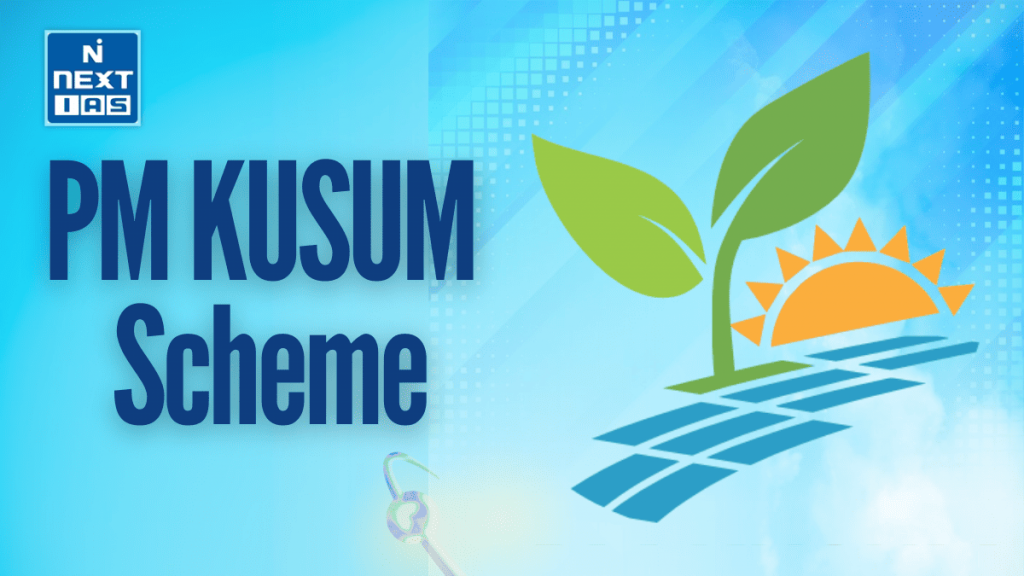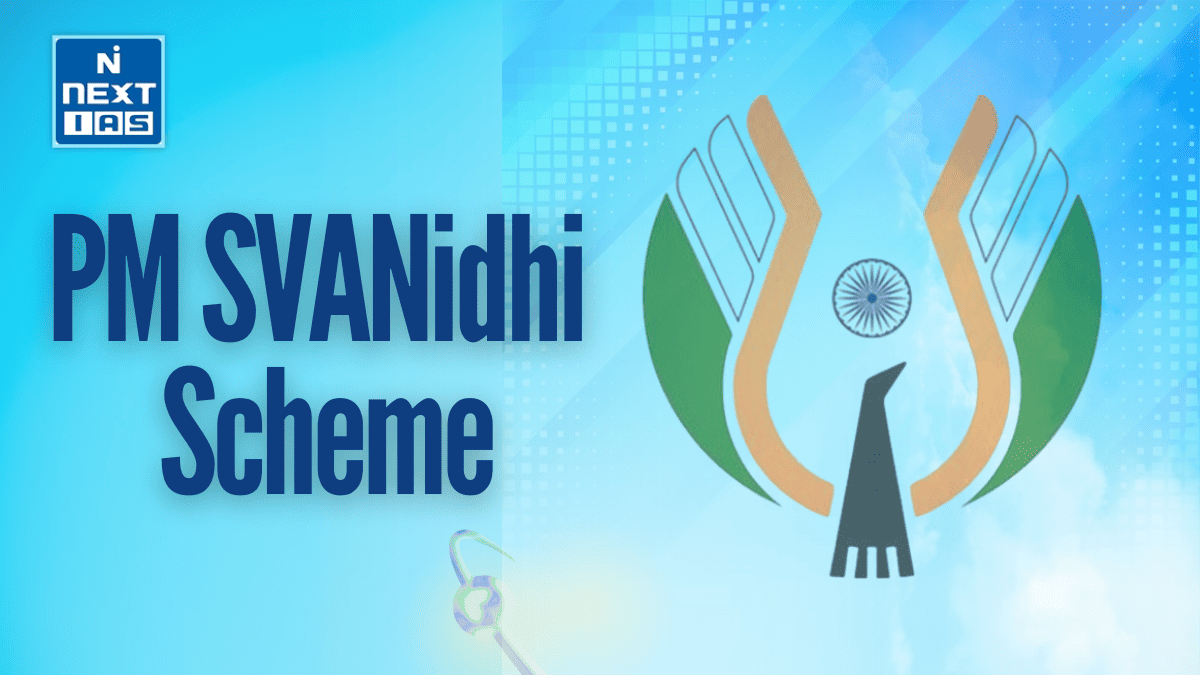
PM-KUSUM (Pradhan Mantri Kisan Urja Suraksha evam Utthaan Mahabhiyan) Scheme is aimed at ensuring energy security for farmers in India, along with honouring India’s commitment to increase the share of installed capacity of electric power from non-fossil-fuel sources to 40% by 2030 as part of Intended Nationally Determined Contributions (INDCs).
About The PM KUSUM Scheme
- The Pradhan Mantri Kisan Urja Suraksha evam Utthaan Mahabhiyan (PM KUSUM) Scheme was launched by the Indian government to promote solar energy use in agriculture. It aims to provide energy security to farmers while reducing their dependence on conventional power sources. The scheme includes three components:
- Installation of standalone solar pumps to help farmers irrigate their fields with renewable energy.
- Solarization of existing grid-connected pumps, enabling farmers to use solar power and sell excess electricity to the grid.
- Setting up decentralized solar power plants (up to 2 MW) on barren or fallow land to generate additional income for farmers.
- PM KUSUM helps reduce carbon emissions, promotes sustainable agriculture, and enhances rural livelihoods by ensuring affordable and reliable power supply. The scheme aligns with India’s renewable energy goals, contributing to energy self-sufficiency and environmental conservation.
Features of The PM KUSUM Scheme
Component A
- Renewable Energy Power Plant (REPP) of capacity 500 kW to 2 MW will be setup by individual farmers/ group of farmers/ cooperatives/ panchayats/ Farmer Producer Organisations (FPO)/Water User associations (WUA) hereinafter called Solar Power Generator (SPG). In the above specified entities are not able to arrange equity required for setting up the REPP, they can opt for developing the REPP through developer(s) or even through local DISCOM, which will be considered as SPG in this case.
- DISCOMs will notify sub-station wise surplus capacity which can be fed from such REPP to the Grid and shall invite applications from interested beneficiaries for setting up the solar energy plants.
- The solar power generated will be purchased by DISCOMs at a feed-in-tariff (FiT) determined by respective State Electricity Regulatory Commission (SERC).
- DISCOM would be eligible to get PBI @ Rs. 0.40 per unit purchased or Rs. 6.6 lakh per MW of capacity installed, whichever is less, for a period of five years from the Commercial Operation Date (COD).
Component B
- Individual farmers will be supported to install standalone solar Agriculture pumps in off-grid areas, where grid supply is not available.
- CFA of 30% of the benchmark cost or the tender cost, whichever is lower, of the stand-alone solar Agriculture pump will be provided. The State Government will give at-least a subsidy of 30%; and the remaining at-most 40% will be provided by the farmer. Bank finance can be availed by farmer, so that farmer has to initially pay only 10% of the cost and remaining up to 30% of the cost as loan.
- In North Eastern States, Ladakh, Jammu & Kashmir, Himachal Pradesh and Uttarakhand, Lakshadweep and Andaman And Nicobar Islands, CFA of 50% of the benchmark cost or the tender cost, whichever is lower, of the stand-alone solar pump will be provided. The State Government will give at-least subsidy of 30%; and the remaining at-most 20% will be provided by the farmer.
Component C: Individual Pump Solarisation (IPS)
- Individual farmers having grid connected agriculture pump will be supported to solarise pumps. Solar PV capacity up to two times of pump capacity in kW is allowed under the scheme.
- The farmer will be able to use the generated solar power to meet the irrigation needs and the excess solar power will be sold to DISCOMs.
- CFA of 30% of the benchmark cost or the tender cost, whichever is lower, of the solar PV component will be provided. The State Government will give at-least subsidy of 30%; and the remaining at-most 40% will be provided by the farmer. Bank finance can be availed by farmer, so that farmer has to initially pay only 10% of the cost and remaining up to 30% of the cost as loan.
- In North Eastern States, Ladakh, Jammu & Kashmir, Himachal Pradesh and Uttarakhand, Lakshadweep and Andaman And Nicobar Islands, CFA of 50% of the benchmark cost or the tender cost, whichever is lower, of the solar PV component will be provided. The State Government will give a subsidy of at-least 30%; and the remaining at-most 20% will be provided by the farmer.
Component C: Feeder Level Solarisation (FLS)
- Instead of the individual solar pumps the states can solarize the agriculture feeders.
- Where agriculture feeders are not separated, loan for feeder separation may be taken from NABARD or PFC/REC. Further, assistance for feeder separation may be availed from the Revamped Distribution Sector Scheme (RDSS) of the Ministry of Power. However, mixed can also be solarised.
- Solar plants of capacity that can cater to the requirement of the agriculture load of the selected feeder can be installed through CAPEX/RESCO mode for a project period of 25 years.
- CFA of 30% on the cost of installation of solar power plant (up to Rs. 1.05 Cr/MW) will be provided. However, in the North Eastern States, Ladakh, Jammu & Kashmir, Himachal Pradesh and Uttarakhand, Lakshadweep, and Andaman And Nicobar Islands 50% (up to Rs. 1.75 Cr/MW) subsidy is available.
- The farmers will get day-time reliable power for irrigation free of cost or at tariff fixed by their respective state.
Objectives of the PM KUSUM Scheme
The PM-KUSUM Scheme allows inter-se transfer of quantities between Component-B and Component-C. All three components of the scheme aim to add Solar capacity of about 34,800 MW by March 2026 with the total Central Financial support of ₹ 34,422 crore.
The PM KUSUM Scheme has the following components:
- Component A:
- Setting up of 10,000 MW of Decentralized Ground/ Stilt Mounted Grid Connected Solar or other Renewable Energy based Power Plants by the farmers on their land.
- Component B:
- Installation of 14 Lakh Stand-alone Solar Agriculture Pumps.
- Component C:
- Solarisation of 35 Lakh Grid Connected Agriculture Pumps including Feeder Level Solarization.
- Scheme Available Till 31.03.2026.
Significance of The PM KUSUM Scheme
- The Pradhan Mantri Kisan Urja Suraksha evam Utthaan Mahabhiyan (PM-KUSUM) Scheme is a transformative initiative aimed at ensuring energy security for farmers while promoting renewable energy adoption. Launched by the Ministry of New and Renewable Energy (MNRE), the scheme plays a crucial role in reducing farmers’ dependence on costly diesel and grid electricity for irrigation, thereby enhancing their income and sustainability.
- One of the key significances of the PM-KUSUM scheme is its contribution to clean energy transition. By promoting solar-powered irrigation pumps and decentralized solar power plants, it helps in reducing carbon emissions and mitigating the adverse effects of climate change. This aligns with India’s commitment to increasing its renewable energy capacity and achieving net-zero emissions by 2070.
- Economically, the scheme reduces farmers’ electricity expenses and provides them an additional source of income by enabling them to sell surplus solar power to the grid. It also enhances energy access in rural areas, particularly in regions with unreliable electricity supply.
- Additionally, the scheme supports the goal of doubling farmers’ income, as envisioned by the government, by reducing input costs and ensuring a reliable power source. It also encourages employment generation in the renewable energy sector through the installation, operation, and maintenance of solar power systems.
- In conclusion, the PM-KUSUM scheme is a sustainable solution for agricultural energy needs, helping India move towards self-reliance in energy while supporting economic and environmental goals.
Lacunae of The PM KUSUM Scheme
The PM KUSUM Scheme, launched to promote solar energy in agriculture, has several benefits, but it also faces multiple challenges and shortcomings:
- High Upfront Costs: Despite subsidies, the initial investment required for solar pumps and grid-connected systems remains high, making it difficult for small and marginal farmers to participate.
- Land Acquisition Issues: The scheme encourages farmers to set up solar plants on barren land, but many lack access to such land. Additionally, land-use conflicts may arise, especially in densely populated agricultural regions.
- Financial and Procedural Hurdles: Farmers often struggle to obtain loans due to lengthy procedures and a lack of awareness. Banks are sometimes reluctant to finance projects due to concerns over repayment.
- Grid Connectivity Challenges: Many rural areas have inadequate transmission infrastructure, making it difficult to integrate surplus solar power into the grid. The lack of proper infrastructure can result in inefficiencies and energy losses.
- Operational and Maintenance Issues: Solar pumps require regular maintenance, and many farmers lack the technical expertise or financial means to ensure their long-term functionality.
- Inequitable Benefits: The scheme largely benefits better-off farmers who own larger land parcels, while small and marginal farmers, tenant farmers, and sharecroppers struggle to access the benefits.
- Delayed Implementation: Bureaucratic delays and coordination challenges between central and state governments have slowed the scheme’s execution, limiting its reach and effectiveness.
PM KUSUM Scheme for UPSC CSE Prelims
- Full Form: Pradhan Mantri Kisan Urja Suraksha evam Utthaan Mahabhiyan (PM-KUSUM).
- Launch Year: 2019 by the Ministry of New and Renewable Energy (MNRE).
- Objective: Promote solar energy in the agriculture sector to reduce dependence on grid power and diesel.
- Components:
- Component-A: Solarization of 10,000 MW grid-connected solar power plants (up to 2 MW capacity each).
- Component-B: Installation of 17.5 lakh standalone solar pumps (off-grid).
- Component-C: Solarization of 10 lakh grid-connected agricultural pumps.
- Target Beneficiaries: Farmers, cooperatives, panchayats, farmer producer organizations (FPOs).
- Financial Assistance:
- Subsidy of 60% from Central & State governments.
- 30% loan from banks.
- 10% contribution by the farmer.
- Environmental Impact: Reduces carbon emissions, promotes renewable energy, and decreases reliance on diesel-based irrigation.
- Implementation: State Nodal Agencies (SNAs) handle execution in coordination with DISCOMs.
- Significance: Supports doubling farmers’ income, ensures energy security, and integrates solar energy into agriculture.
- Recent Update: The scheme extended till 2026 to meet renewable energy targets.
Way Forward
The PM KUSUM Scheme should focus on expanding coverage, easing financial access, ensuring efficient implementation, and integrating advanced solar technologies. Strengthening farmer awareness, promoting decentralized solar grids, and enhancing subsidy frameworks will boost adoption, ensuring long-term sustainability, energy security, and rural empowerment in India’s agricultural sector.
Conclusion
The PM KUSUM Scheme empowers farmers with sustainable energy solutions, reducing reliance on fossil fuels and cutting electricity costs. By promoting solar-powered irrigation and decentralized renewable energy, it enhances energy security, boosts rural incomes, and supports India’s clean energy transition, contributing to environmental sustainability and agricultural resilience.





